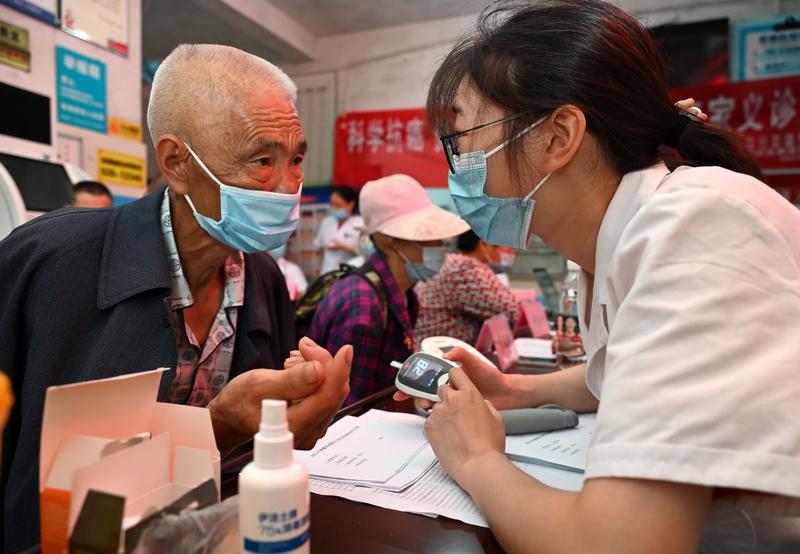All-encompassing system collects key data to facilitate related research
 A medical worker tests the blood sugar of a cancer patient during a free health check in Neijiang, Sichuan province, on June 9. (LI JIANMING / FOR CHINA DAILY)
A medical worker tests the blood sugar of a cancer patient during a free health check in Neijiang, Sichuan province, on June 9. (LI JIANMING / FOR CHINA DAILY)
China has built an all-encompassing cancer registry and has significantly increased cancer patients' chances of survival thanks to efforts in narrowing regional treatment capacity and stepping up early screening, according to experts and a recent report.
However, they said that new cancer cases and deaths remain high, and rolling out more refined screening programs is the key to tackling them.
He Jie, director of the National Cancer Center and an academician at the Chinese Academy of Sciences, said last month that China has set up a cancer registration system to collect key data on rates of incidence, survival and deaths and inform related research, prevention and control work.
To address the uneven distribution of medical resources, He said that China has so far built 24 provincial-level cancer centers and more than 100 city-level tumor centers or hospitals, forming a preliminary structure of a national cancer treatment network.
He added that a series of screening, early treatment and diagnosis programs targeting typical cancers in urban areas, rural regions as well as those among women and girls have been rolled out.
By the end of last year, central funds had subsidized 180 million free cancer screening tests, and the local funds of 15 provinces had covered 60 million free screening examinations, he said during the 10th Annual Meeting of the National Cancer Center held in Taiyuan, Shanxi province, from March 24 to 26.
He Wei, vice-chairman of the Standing Committee of the National People's Congress, said during the event that an initial model of China's cancer prevention and control mechanism has taken shape.
A highlight in recent years has been the launch of a cervical and breast cancer screening program targeting rural women and girls, leading to declines in their death rates.
In China, the five-year overall survival rate of cancer has risen from 30.9 to 40.5 percent over the past 10 years.
However, He Wei also noted that the rate is still lower than that in developed countries, suggesting a formidable task ahead to fight cancer.
A paper published by The Chinese Journal of Oncology this month said that the incidence rate of cancer in China keeps increasing, reflecting a growing burden of the disease.
The paper, co-authored by He Jie from the National Cancer Center, offered a detailed look into cancer cases across the country in 2016.Such reports are usually delayed for several years due to time spent collecting and analyzing data.
The paper said that China reported about 4.06 million new cancer cases and 2.41 million deaths in 2016.The top five most common cancers nationwide are lung, colorectal, stomach, liver and breast cancers.
The paper said that while the incidence of conventionally common cancers such as esophageal, stomach and liver cancers was trending downward, their burden remained heavy. Meanwhile, cancers that are more prevalent in developed countries, such as breast, thyroid and prostate cancers, were becoming more common in China.
Wang Guiqi, head of the endoscope department at the Cancer Hospital of the Chinese Academy of Medical Sciences, said that health awareness of Chinese people has improved in recent years. For instance, the country performed around 38 million endoscopy or colonoscopy tests in 2022, up from 28 million in 2012.
However, the early diagnosis rate of gastrointestinal cancer stands at around 17 percent, lagging behind that in developed countries.
He said that early screening tools for cancer should be convenient and accessible and should not scare away people due to discomfort involved during procedures.
Wang also suggested conducting a preliminary risk evaluation to screen out high-risk groups, who can take more precise screening examinations at hospitals.
He Jie, from the National Cancer Center, said that the five-year survival rate of early-stage cancer patients can usually reach 90 percent, while the rate among late-stage patients is lower than 50 percent.
He said enhancing early screening and promoting standardized diagnosis and treatment protocols are vital in boosting survival rates.


